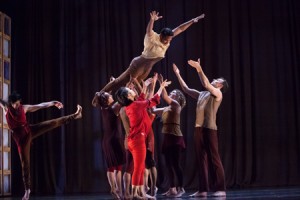CFA Arts Administration Intern Chloe Jones ’15 talks to Virgil Taylor ’15, Sewon Kang ’14, and Stratton Coffman ’14 about the exhibition “Evan Roth//Intellectual Property Donor,” on display in the Ezra and Cecile Zilkha Gallery through Sunday, March 2, 2014. Admission to the gallery is free.

On display now in the Ezra and Cecile Zilkha Gallery is the exhibition Evan Roth//Intellectual Property Donor. This is the largest one-man show to take place in the United States for the Paris-based American artist.
Blurring the line between artist and hacker, the exhibition asks gallery visitors to consider how everyday life intersects with virtual reality and how viral media can become high art.
Beautiful, curving, white sculptures are suspended from the gallery ceiling, each one algorithmically produced from motion-tracked graffiti data. Across the gallery, an interactive installation invites visitors to create their own TED talks on a stage that looks startlingly identical to the TED stage. Covering one wall is a series of 1,540 smartphone screen-sized ink prints depicting the gestures required to beat all 300 levels of the popular game “Angry Birds.”
With an interest in the overlap between free culture and popular culture, Roth transforms existing systems into public, often political, statements. As part of the exhibition, visitors can obtain a small sticker that reads: “In the event of death please donate all intellectual property to the public domain.” Perfect for the back of your driver’s license, he wryly suggests.
Roth was on campus for a week leading up to the opening reception on the evening of Wednesday, February 5, 2014. I spoke with three Wesleyan students who had the opportunity to work directly with him during that time.
Studio Art major Virgil Taylor ‘15 first met Roth when the artist visited Wesleyan last year. Intrigued by his work, Taylor signed up to help with the Evan Roth//Intellectual Property Donor exhibition and returned to campus early from winter break in order to begin preparing for the show’s opening.
One work in the exhibition, Propulsion Painting, consists of a variety of mixed-media sculptures that use the pressure within spray paint cans to perform tasks such as the one in this video.
Roth needed 70 empty spray paint cans! Taylor emptied what cans he could by repainting all the stools in two classrooms, and spent the rest making a series of paintings. Done on canvases typically used in the installation of exhibitions, the series was titled In Conjunction and displayed in South Gallery next door to the Evan Roth//Intellectual Property Donor exhibition on opening night.
“It ended up being a really productive experience and a really great exercise for me,” says Taylor, who had never worked with spray paint before. Taylor also attended a daylong workshop held by Roth on the topic of hacking culture, in which students made mini projects based on systems they observed in their surroundings. “It was a really fast process: talk about it, identify a system, do something,” Taylor describes.
Here is an artist interested in talking about ideas, observing the world, and then acting. The internet, Roth argues, is not only a means of communication but also a rich artistic medium and a potent vehicle for activism.
Creative Campus Intern Sewon Kang ’14 also attended the workshop. According to her, “Evan works with infrastructure that is already there for him to subvert, so when he talks about activism he talks about how activists don’t necessarily need to go in and build from the ground up.”
Roth’s activism takes place through creativity and innovation, always seeking to make small interventions that will attract worldwide attention.
“There are already systems in place that you can change to work to your advantage,” explains Kang. “Roth sees everything in the world as an opportunity. Where I see a room full of tables and chairs, he sees the tables and chairs as a system for some sort of intervention.”
Zilkha Intern Stratton Coffman ’14 also spoke about the activist impulse running through Roth’s work. “He’s asking, in what ways can we exploit the technological and social systems that are already there to change not only our environments, but also what it means to be an agent in the world.”
Coffman was first introduced to Roth’s work last year when the proposal to bring Evan Roth//Intellectual Property Donor to Wesleyan came before the Zilkha Planning Committee.
“I was intrigued,” Coffman remembers. “What’s alluring about his work is its interconnectedness. It’s part of a larger practice, each individual work, which makes them all more complex.”
Having followed Roth’s journey to Wesleyan and interacted with him and his work on numerous different occasions, Coffman says, “There are still interesting questions to think about, which is partly why I think it’s such a fruitful show. There are these questions in the works that are not resolved.”
Evan Roth//Intellectual Property Donor is more than an art exhibition, it is a catalyst for creative thinking and a commentary on our world, a call to action and an interactive sensory feast.
The exhibition will be open through Sunday, March 2, 2014 at 5pm. Visit the exhibition website for more information, photos, and the video of the artist talk that Roth gave on the night of the opening.



